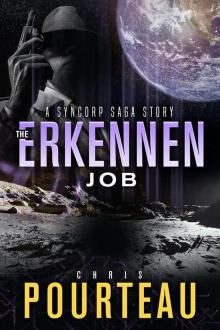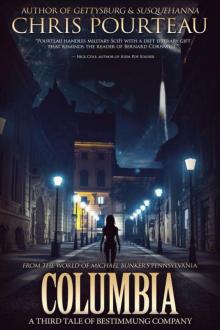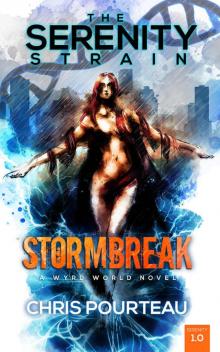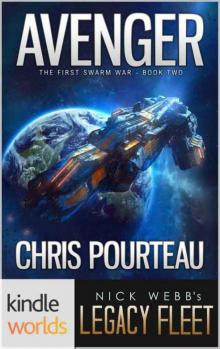- Home
- Chris Pourteau
Stormbreak (The Serenity Strain Book 1)
Stormbreak (The Serenity Strain Book 1) Read online
Praise for The Serenity Strain: Stormbreak
Fast moving and exciting, [this novel] is a cracking mix of disaster movie and post-apocalyptic thriller. The overall plot felt like something Stephen King would put together — it’s got that combination of everyday people being dropped into an extreme situation with a few supernatural twists thrown in to liven things up even more.
—Philip Harris, author of Glitch Mitchell and the Unseen Planet
This was simply a great read! It started off with a bang and the excitement just kept building. I found the multiple hurricanes scary enough but the failed attempt to control antisocial behavior through genetic manipulation gave me shivers (partly because I believe we’re on the verge of that type of “therapy”). If you like thrills and chills, this is the book for you!
—Jenni Townzen, Amazon reviewer
I can’t tell you how long it’s been since I read a book as quickly as [Stormbreak…. It] clicks on the afterburner and doesn’t let you go, even at the end. Great “real” characters that most everyone in this fractured-family society can understand lead the battle against overwhelming evil. I got a Stephen King vibe … at times and that was very comfortable to me. I highly recommend reading this…. I can’t wait for [the] next installment.
—Christopher Boore, author of Kamika-Z
This one’s a nail biter that will have you reading through it in one sitting and the character development will be tugging at your heart strings as you pull for the Hughes family to make it out of this hellstorm alive.
—discodog88, Amazon reviewer
You’ll love [Stormbreak] if you love great thrillers. In a very Dean Koontz-esque novel, Pourteau has given [readers] a wonderful and frightening tale.
—Will Swardstrom, author of the Dead Sleep Trilogy
Chris does a fantastic job of describing the tangled web of emotions that comes in separated or divorced families. He expertly used the chaos of a prison break, 3 massive storms and a broken family to draw the reader along into his tale.
—AnneHope, Amazon reviewer
A family going through divorce reunites to fight a common enemy and survive the deadly coils of an evil bigger than they ever imagined. A hard to put down page turner.
—Vince, Amazon reviewer
Rogue viruses, wild hurricanes and non-stop action dominate … and the Maestro and his associates will definitely make your skin crawl. Yet there are also moments of reflection and quiet as Mark and Lauryn explore the ways in which their marriage went wrong, and are forced to work together to try to save themselves and their daughter from the darkness that is taking over their part of the world. You won’t want to put [Stormbreak] down until the very last page.
—Jennifer Ellis, author of Reversal and the Derivatives of Displacement series
This book is really amazing & the devastation of poor old Houston by multiple hurricanes is superbly described….. bringing back not too-old memories of New Orleans and the suffering and chaos! But … the most important aspect of this story [are] the challenges which arise for a broken family, as they try to become “un-broken” in order to survive….
—Seamus, Amazon reviewer
With an ending that left me thunderstruck and emotionally ripped apart, there are some dangling threads that could continue into sequels to this book. And you will definitely want to see what transpires next. I know I really, really want to see how the author follows up with this one and how he continues the storyline established.
—Chris F., Amazon reviewer
[The Serenity Strain: Stormbreak] is a tale of disaster, hope, murder, redemption and unlikely heroes. Mr. Pourteau’s style is clean and fast-paced, making this a very quick read. The action is non-stop and moves at a breakneck speed in key scenes. In fact, I found myself having to re-read the climax. Not because it was unclear, but because the pace had me reading so fast, I found I missed a few things. This is not a book to pick up at night, if you have an early morning ahead of you.
—Bob Crosley, author of Shelf Life
The Serenity Strain
Stormbreak
by
Chris Pourteau
Second Edition Produced by
Text copyright © 2015 by James C. Pourteau and Hip Phoenix Publishing.
First Kindle Edition: February 2015
ISBN 978-0-9899813-7-8
Second Kindle Edition: February 2016
ISBN 978-0-9899813-8-5
Thank you for purchasing this ebook. It is a work of fiction. Any similarity to real persons, living or dead, is coincidental and not intended by the authors.
Aspects of some of these stories are inspired by worlds created by their respective authors. Used with permission of the authors.
No part of this book may be reproduced, or stored in a retrieval system, or transmitted in any form or by any means, electronic, mechanical, photocopying, recording, or otherwise, without express written permission. Permission must be obtained from the individual copyright owners as identified herein.
ALL RIGHTS RESERVED.
Cover design copyright © 2016 by Adam Hall. http://aroundthepages.com. All rights reserved. Used by permission.
Cover illustration © 2015 by Ben Adams. All rights reserved. Used by permission. http://www.benjadams.com.
Editing by Ellen Campbell. http://ellencampbell.thirdscribe.com/.
Ebook formatting by Polgarus Studios. http://www.polgarusstudio.com.
For the independent publishing community for nurturing my craft with fast friendship and honest feedback
Table of Contents
Foreword to the Second Edition
A Blog Response: God and I Can Work Together
Part 1: Hurricane Party Chapter 1. Tuesday, morning.
Chapter 2. Tuesday, afternoon.
Chapter 3. Thursday, afternoon.
Chapter 4. Thursday, evening.
Chapter 5. Friday, morning.
Chapter 6. Friday, afternoon.
Chapter 7. Saturday, early morning.
Part 2: Human Trials Chapter 8. Saturday, early morning.
Chapter 9. Saturday, early morning.
Chapter 10. Sunday, early morning.
Chapter 11. Sunday, morning.
Chapter 12. Sunday, morning.
Chapter 13. Sunday, morning.
Chapter 14. Sunday, morning.
Part 3: Feral State Chapter 15. Sunday, afternoon.
Chapter 16. Sunday, evening.
Chapter 17. Sunday, night.
Chapter 18. Sunday, night.
Chapter 19. Sunday, night.
Chapter 20. Monday, early morning.
Chapter 21. Monday, dawn.
Afterword
Acknowledgments
A Word to My Reader
About the Author
Foreword to the Second Edition
This novel was originally published as Apocalypse Weird: The Serenity Strain, part of the Apocalypse Weird publishing initiative from Wonderment Media, Inc. What a great idea that was—to have multiple authors writing different novels all tied to a central narrative. Unfortunately, Wonderment didn’t make a go of it. But the principals of that company allowed their authors to retake control of their novels and the intellectual property in them. So I’ve republished TSS as The Serenity Strain: Stormbreak, the first in a series of novels that continues the storyline I began with my fellow Weird-o’s in Apocalypse Weird. And it’s still part of a larger world—Nick Cole’s Wyrd World novels, which capture his own contributions to the world of Apocalypse Weird. Like me, Nick is continuing his storyline begun in The Red King.
Although Wonderment Media, Inc., is no more, I want to take a moment and thank
the principals involved with that venture: Michael Bunker, Nick Cole, Tim Grahl, and Rob McClellan. The Apocalypse Weird initiative gave some largely unknown authors like myself the chance to take our craft to the next level—readership, productivity, and quality wise. All-wise, really. So, thank you guys for the opportunity to contribute to Apocalypse Weird and, especially, for allowing me to be one of the first writers Wonderment Media chose to publish. I was truly honored to be a part of that amazing experience.
The original publisher is gone, but the story is still here. In fact, it continues in the sequel, The Serenity Strain: Ironheart, which is coming in spring 2016. So sit back, turn the page, and I hope you enjoy The Serenity Strain: Stormbreak.
Chris Pourteau
February 2016
A Blog Response:
God and I Can Work Together
by Regent Fellow Eamon Stavros, Ph.D.
A week ago yesterday, The University of Texas published a press release about my current research project involving gene therapy. An article about this research recently appeared in The American Journal of Human Genetics. A visceral reaction has gone viral across the Internet, snowballing into some very negative, hurtful, and unproductive exchanges that have little to do with science. As the First Believer in my own research and its promise for humanity, I feel compelled to answer these critics with this blog post.
The Serenity Virus: The Evolution of Genetics Research
Serenity is the natural next step in behavioral research linked to genetics. In 2010, scientists discovered the impulse-control center in the brain’s medial prefrontal cortex. The center is a controlling mechanism related to ADHD, criminal activity, and addictive behaviors.
Following this discovery, scientists from Finland and France studied a sample of violent criminals. They found common elements in the crimes, namely that they were unplanned and pointless. And they discovered that deactivating the HTR2B gene correlated with producing highly impulsive behavior. (In the brain, the HTR2B gene encodes one type of serotonin receptor that influences numerous behavioral expressions—including emotion-driven, or knee-jerk, behavior.) Further experiments demonstrated that mice exhibit higher levels of impulsive behavior after deactivating the HTR2B gene.
Building on these research findings, our hypothesis at UT was this: if we can increase expression levels of the HTR2B gene and its encoding of serotonin, perhaps we can control the impulsive behaviors that correlate with “unplanned and pointless” actions. In other words, through gene therapy, perhaps we can make violent criminals less likely to commit violent crimes. Society is safer. Recidivism is reduced. Conceivably, taxpayer costs associated with long-term housing and care of violent criminals could be decreased as well. And other applications for this therapy—like ADHD issues in children and addictions related to drugs, alcohol, and pornography—also show great promise for responding to manipulation of the HTR2B gene.
How Discoveries Move from the Lab to the Store Shelf
That, stripped to its bare bones, is our goal at UT’s Center for Genetics Research and Human Application. Conspiracy theorists have charged me with creating a get-rich quick scheme funded by taxpayer dollars. Nothing could be further from the truth. Perhaps these individuals are unaware how university research is commercialized. Let me take this opportunity to tell you how that works.
A professor makes a discovery or creates a new technology. How does it get from the laboratory to the store shelf to benefit the public? University professors don’t have the resources of a private corporation. So we develop our ideas in stages and, in some cases, commercialize them to benefit the public. Returning value to taxpayers that fund it is a primary goal of every publicly financed university.
In 2013, UT created a company called GeneSerene, Inc., to help fund my research. Through private venture capital and public matching funds, we’ve advanced the development of the HTR2B gene therapy to Phase One clinical trials. (The press commonly refers to this therapeutic approach as “the Serenity Virus,” by the way, but that’s just the mechanism for delivering the therapy.) For the first time, we’re working with human beings; more on that in a moment.
So, How Does Serenity Work?
We introduce the Serenity retrovirus into a test subject. It carries genetic coding to be spliced in the place of existing genes. Using technology developed at MIT in 2009 called “multiplex automated genome engineering” (or MAGE), we cut and paste specific genetic sequences. The virus is cleared by the body’s immune system quickly, of course, but it leaves behind its genetic payload. In short, the unwanted gene sequences are replaced without affecting the rest of the genome. My elevator speech for the process is this: “We’re cutting and pasting bits of DNA, just like you cut and paste words when you edit a document on your computer. We’re reworking a sentence of human DNA to make it better, more effective.”
Specifically, in the case of Serenity, we can introduce genetic code into the host cell’s DNA that increases the expression levels of the HTR2B gene and its corresponding levels of serotonin to mollify impulsive, even violent behaviors.
Once introduced, the new genetic material enhances activity in the specific serotonin receptors associated with impulse control. Lab rats and higher mammals (e.g., monkeys) that previously exhibited high levels of impulsivity have responded well to Serenity’s naturally calming effect. In fact, scientists in China have rewritten DNA in monkeys with some success. And researchers in the Netherlands are approaching a cure for cystic fibrosis using a similar process.
Progress So Far
The objective of any Phase One trial is to prove that the therapy under study is safe for humans. That’s why scientists use only a small number of test subjects at this stage. In our case, the results we’re seeing with Serenity are beyond our original expectations.
As fully disclosed in UT’s press release, the individuals in our trial are incarcerated at the Texas State Prison in Huntsville, Texas, and have traded their participation for the possibility of receiving reduced sentences. However, those sentences will only be reduced if the therapy produces measurable behavioral improvements that remain in place five years after the conclusion of our Phase One trial.
In just six weeks, we’ve seen significant changes in five of our six human test subjects. One individual in particular—we’ll call him Mr. M, to protect his anonymity—has shown dramatic behavioral improvements since beginning the therapy. More than a decade ago, Mr. M was convicted of brutally murdering a family of six with an axe. He showed absolutely no remorse at trial. His spree was apparently random and purely sadistic in nature. Before Serenity, Mr. M had a reputation for flying into uncontrollable rages for no reason at all. But since beginning our gene-replacement therapy, members of my team—some of whom were initially afraid to sit across the table from Mr. M—are now able to have a normal, cordial conversation with him. His progress is quite promising.
In Conclusion
I might be overloading you with information, but I felt it important to address each of my critics’ questions in turn. Yes, I and the university will likely make money via the sale of GeneSerene, Inc., should the private sector choose to purchase the company. But I firmly believe that capitalism in the cause of public service is a noble purpose for scientists in the academic community. These days, it’s certainly a necessary avenue to securing research funding. While working at the University of Pittsburgh, Jonas Salk developed his polio vaccine funded by a national foundation grant. In today’s cash-strapped reality—where less government funding is available for such endeavors—the Salks of today, like myself, must turn to the private sector to finance their world-changing discoveries. That isn’t evil. It’s just the way it is.
One vociferous individual suggested ever-so eloquently that I, through my research, am “flipping the bird at God.” Let me assure you, God and I are partners. Just as He is a partner with every scientist who dares to question what we think we know and every medical practitioner who seeks to intervene on behalf of his
or her patients. God gave me my intelligence. It is only fitting that I seek to solve more of His mysteries by exercising it. To do less? Now, that would be spitting in the face of God.
If anyone would like to question my empirical approach, my methodology, or how I arrived at my data—I’m glad to respond. But this is my first and last attempt at placating the lowing herd of Cyberspace, who are more interested in increasing advertisement revenue on their websites through sensationalism than they are in debating intellectual matters in an unbiased fashion. I will now return to my work, knowing its value will likely be acknowledged only long after I am gone.
Eamon Stavros, Ph.D., Professor of Genetics, Holder of the George Streisinger Endowed Chair for Genetics Research
--- COMMENT ---
I’m with you, Eamon! Your work is groundbreaking and deserves your full attention. Ignore the bees buzzing around. Stay the course, my friend. – UTGeneProf13
--- COMMENT ---
Thank you for your explanation. I agree that you shouldn’t stop your research because idiots who don’t understand it start caw-caw-cawing like crows. Keep up the good work! – MotherJuggsNeedsSpeed
--- COMMENT --- (Comment deleted by moderator as unhelpful to the discussion)
Here’s MY SERMON. You are building a damn GENETIC MURDER MACHINE that’s gonna get loose on you and everyone worth caring about and we’ll be writing the last pages of humanity’s story because you’re playing the role of Dr. Frankenstein for a few dollars more and flying in the face of all creation (and I ain’t religious I just know an abomination when I see it). Glad to see that some Internet friends of mine have started to notice your sneaking horror after I pointed it out.–DocMidnite4Good

 Masada's Gate
Masada's Gate Valhalla Station
Valhalla Station The Erkennen Job
The Erkennen Job Susquehanna
Susquehanna Columbia
Columbia Gettysburg: A Tale of the Second War for Pennsylvanian Independence
Gettysburg: A Tale of the Second War for Pennsylvanian Independence Tales of B-Company: The Complete Collection
Tales of B-Company: The Complete Collection Ironheart (The Serenity Strain Book 2)
Ironheart (The Serenity Strain Book 2) Stormbreak (The Serenity Strain Book 1)
Stormbreak (The Serenity Strain Book 1) Legacy Fleet: Avenger (Kindle Worlds) (The First Swarm War Book 2)
Legacy Fleet: Avenger (Kindle Worlds) (The First Swarm War Book 2) Shadows Burned In
Shadows Burned In